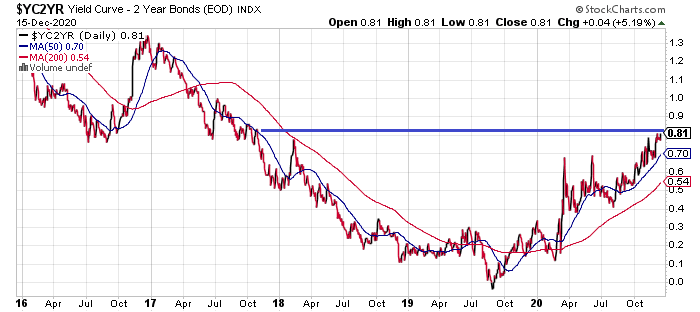The Federal Reserve is widely expected to reaffirm its ultra-dovish monetary policy in today’s FOMC meeting and the futures market continues to price the odds of a rate hike at 0% deep into 2021. But real-world conditions in government bond trading are hinting, if only on the margins, that a post zero-forever world may not be forever after all.
Exhibit A is the gradual but persistent steepening in the Treasury yield curve over the past year-plus. The current 10-year/2-year spread, at +81 basis points (Dec. 15), is still unusually low by historical standards. But the spread has also been trending higher, in fits and starts, for a year-and-a-half and is now at a three-year high.

The US economy still faces a harsh winter as Covid-19’s spread continues to take an ever greater toll in lives and livelihood. But the 10-year/2-year spread has been quietly, persistently pricing in something other than a worst-case scenario. The shift has been slight, but after 1-1/2 years, the change is becoming conspicuous.
A similar recovery has been unfolding in the 10-year/3-month too, which is currently at +84 basis points.

A steepening yield curve is traditionally viewed as a market forecast for higher inflation and/or strong economic activity. By some accounts, both conditions apply.
“We don’t really see any need for the Fed to extend its average maturity of its portfolio purchases given the fact that financial conditions are extraordinarily easy,” says Subadra Rajappa, head of US rates strategy at Societe Generale. “Yes, the curve has steepened, but inflation expectations have also risen meaningfully. The employment picture continues to improve.”
Learn To Use R For Portfolio Analysis
Quantitative Investment Portfolio Analytics In R:
An Introduction To R For Modeling Portfolio Risk and Return
By James Picerno
Now that coronavirus vaccines are starting to roll out, it’s getting easier to envision a healing process in 2021 for the economy. The repair and recovery process is showing up in GDP nowcasts for the fourth quarter and in Q1 estimates for 2021. The Atlanta Fed’s GDPNow model, for example, is especially upbeat for this year’s Q4 data: the current estimate points to a strong 11.2% annualized increase (as of Dec. 9).
The New York Fed’s Q4 GDP nowcast is substantially weaker – 2.5%. But the bank’s Q1 estimate perks up to 5.9%.
Treasury market inflation expectations are also rising. The implied inflation outlook, based on the yield spread for the 10-year nominal and inflation-indexed rates, is 1.91% — the highest since May 2019.

Treasuries are anticipating recovery for 2021, but the economy still has to run a final coronavirus gauntlet over the next several months. The vaccines won’t be widely distributed until the spring at the earliest and so the Covid-19 blowback will likely get worse before it gets better.
In the immediate future, one of the biggest macro risks is the ongoing surge in new worker layoffs every week. Last week’s update was especially worrisome: new filings for unemployment benefits in the first week of December jumped to a three-month high of 853,000. In fact, claims have been increasing at 700,000-plus continually since the pandemic started. In other words, the economy is still shedding jobs at a rate that exceeds the darkest points in the recessions over the past 50 years.
Of all the economic risks that are weighing on the economy, the worrisome trend in jobless claims is at the top of the list. Until claims fall sharply from current levels, the economic recovery will be wobbly at best. There’s also a non-trivial risk that the ongoing loss of employment will throw the US into a new recession.
“The surge in initial claims is especially concerning when claims are still above levels near the peak of the Great Recession,” notes Glassdoor senior economist Daniel Zhao.
The steepening yield curve suggests that the Treasury market is betting that the claims filings will soon fade and the labor market’s recovery will strengthen. But the Treasury market’s forecasting efforts come in several flavors. The nominal 10-year rate, for example, is recovering but modestly and on this front the upbeat outlook is relatively muted. Indeed, the current 0.92% 10-year rate is still far below the pre-pandemic 1.5%-2.0% range — a sign that the crowd’s appetite for safety remains elevated.

The Treasury market, in sum, is hedging its bets. The yield curve is increasingly bullish on 2021’s prospects. The benchmark 10-year rate, by contrast, has yet to fully embrace that forecast. A key factor: surging jobless claims. Unfortunately, deteriorating conditions with coronavirus suggest that better days for claims are nowhere on the immediate horizon. As a result, the continued upside trends for rates and the yield spread appear challenged until claims begin to drop substantially.
How is recession risk evolving? Monitor the outlook with a subscription to:
The US Business Cycle Risk Report
Pingback: Pandemic-Impacted Assets Will Bounce Back in 2021 But It May Not Last
Pingback: Weighing The Week Ahead: What Can Investors Expect Before Springtime? - TradingGeek.com
Pingback: Two Light Weeks Ahead for Economic Reports - TradingGods.net